The first game set in the “new” 40k universe
Type: Singleplayer, Multiplayer
Genre: Strategy, Tactics
Developer: Black Lab Games
Publisher: Slitherine Ltd.
Release date: 22 July, 2021


The Warhammer 40,000 franchise has been going strong for over 30 years at this point, and it’s showing no signs of slowing down. Though until very recently the actual setting itself had remained largely unchanged since at least 1998, with only a few tweaks being done here and there to make room for new stuff that Games Workshop could sell us (at a really high price). But with the release of 8th edition Games Workshop decided to do something risky, they moved the timeline forward and actually made things happen in the 40k universe once more.
Battlesector is the first game (outside of a few mobile releases) to fully embrace some of the changes that was brought in with the advancing timeline, and throws you right into the ongoing conflict, leading the venerable Blood Angels chapter into battle against the great devourer. This is a squad-level turnbased tactics game similar to the excellent Sanctus Reach, although it greatly expands on quite a few things compared to that game.
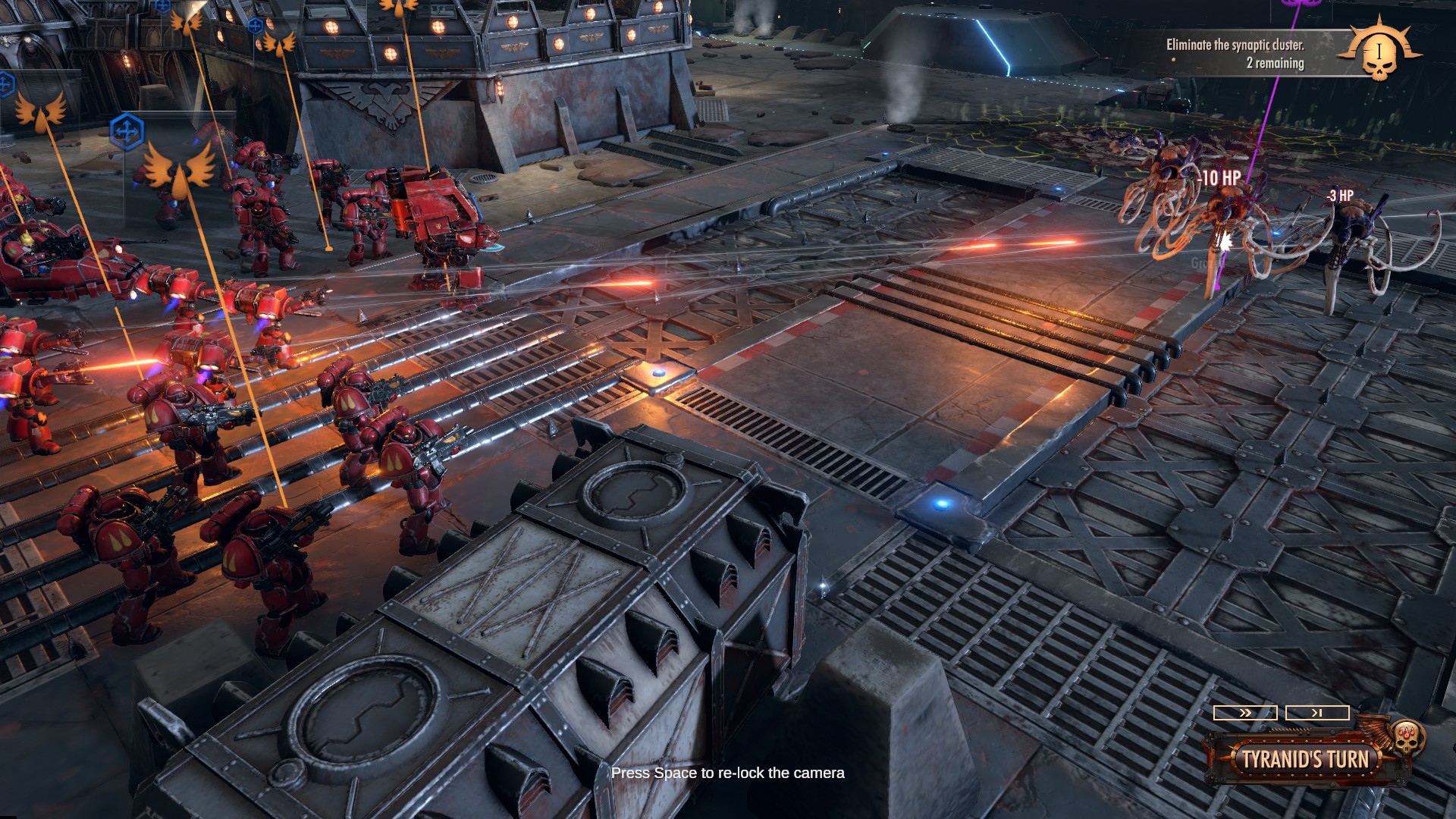
Story & Setting
The 40k universe is far too big to properly explain in a review, and for someone who’s brand new to the setting the story of Battlesector might not make a whole lot of sense. Who are these weird red space marines, why are there suddenly warrior nuns helping them and what’s the importance of the fact that the marines go crazy and try to kill everything around them?
In Battlesector you’re leading the forces of the Blood Angels space marines against the insectoid tyranids who infest one of the moons of the planet of Baal, the home of the Blood Angels. Space Marines, blood angels included, are genetically enhanced humans clad in some of the best armour humanity has ever made, and are humanity’s first line of defense against the horror that lurks everywhere, and the Blood Angels are some of the most renowned space marines. But the Blood Angels are not perfect, they have a defect in the genetic material that’s used to make them into space marines, and this defect can throw them into fits of rage or even make them seek death on the battlefield, with no regard for those around them.
Space Marines are not necessarily good guys, while they defend the imperium of man from its many foes the imperium itself is a huge and uncaring organization that’s willing to sacrifice billions of people every day in order to keep its machinery running. It’s oppressive, with free thought being considered a sin and anyone who does not obey its commands is branded traitors. Life in the imperium is harsh, with the masses at the bottom suffering under its rule. And the Space Marines are hardly even human anymore, with many of them having lost touch with their humanity, and being more than willing to perform atrocities not just to defend the imperium, but to protect themselves from scrutiny.
The Tyranids on the other hand are like a swarm of locust, devouring everything in their path. Most organisms in the tyranid hive fleets are little more than mindless animals, but they are often lead by other, more intelligent, creatures, some of which have minds keener than even those of the greatest strategists of the imperium. And much like the imperium the Tyranids don’t value the lives of their lesser creatures, willing to throw waves of them against the waiting guns of the opposition with no concern for their survival.
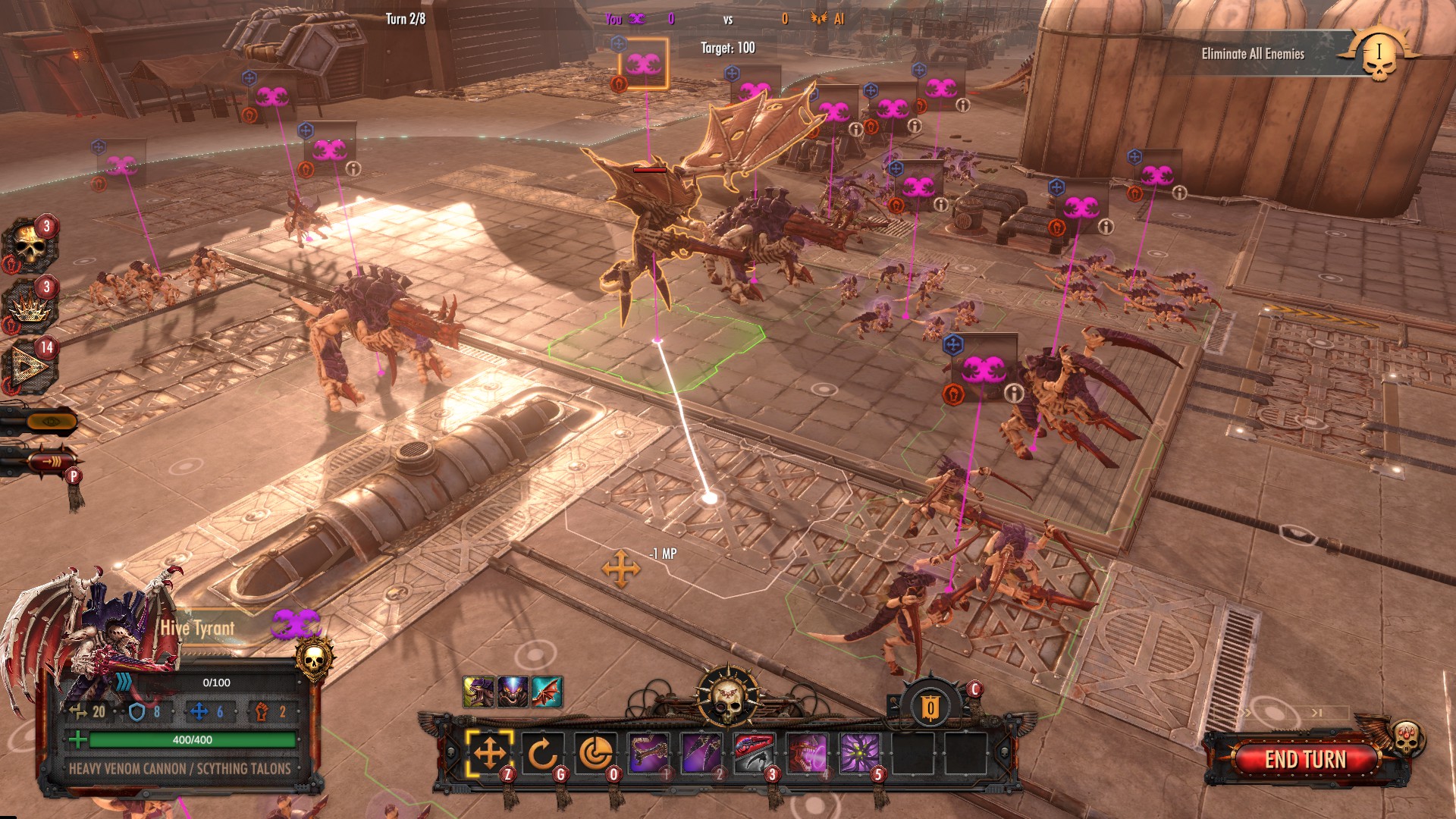
It looked like Baal was about to fall to the Tyranid swarm when a great rift opened up in space to the immaterium, a parallel plane of existence filled with horrors beyond even the tyranids, and large parts of the hive fleet was lost in this rift. While the rift tore the imperium in half it did save the Blood Angels from a certain death.
Battered and nearly beaten the Blood Angels suddenly receive help from an unexpected source. Reinforcement suddenly arrive in the form of Primaris Marines. These are a new breed of Space Marines that’s been created by the Imperium and bolter the ranks of the Blood Angels. And now they, with the help of these new marines, need to wipe out the last remaining Tyranids on the second moon of Baal, before the Tyranids can find a way to help their brethren escape from the warp rift.
Only the last paragraph is really information that’s given in the game, which would leave anyone who’s not been following what’s been going on in the Warhammer 40,000 universe confused were they to boot up this game.
Sadly the story in Battlesector is not very good. It feels like a pretty inconsequential side-plot in a grander story, which is pretty much what it is. But the writing on the other hand is remarkably strong. It captures the conflicted feelings some of the old Space Marines feel about these new Primaris marines, and also some of the conflicts within the Imperium itself. The Imperium is not as unified as it might first seem, and not everyone sees things the same way.
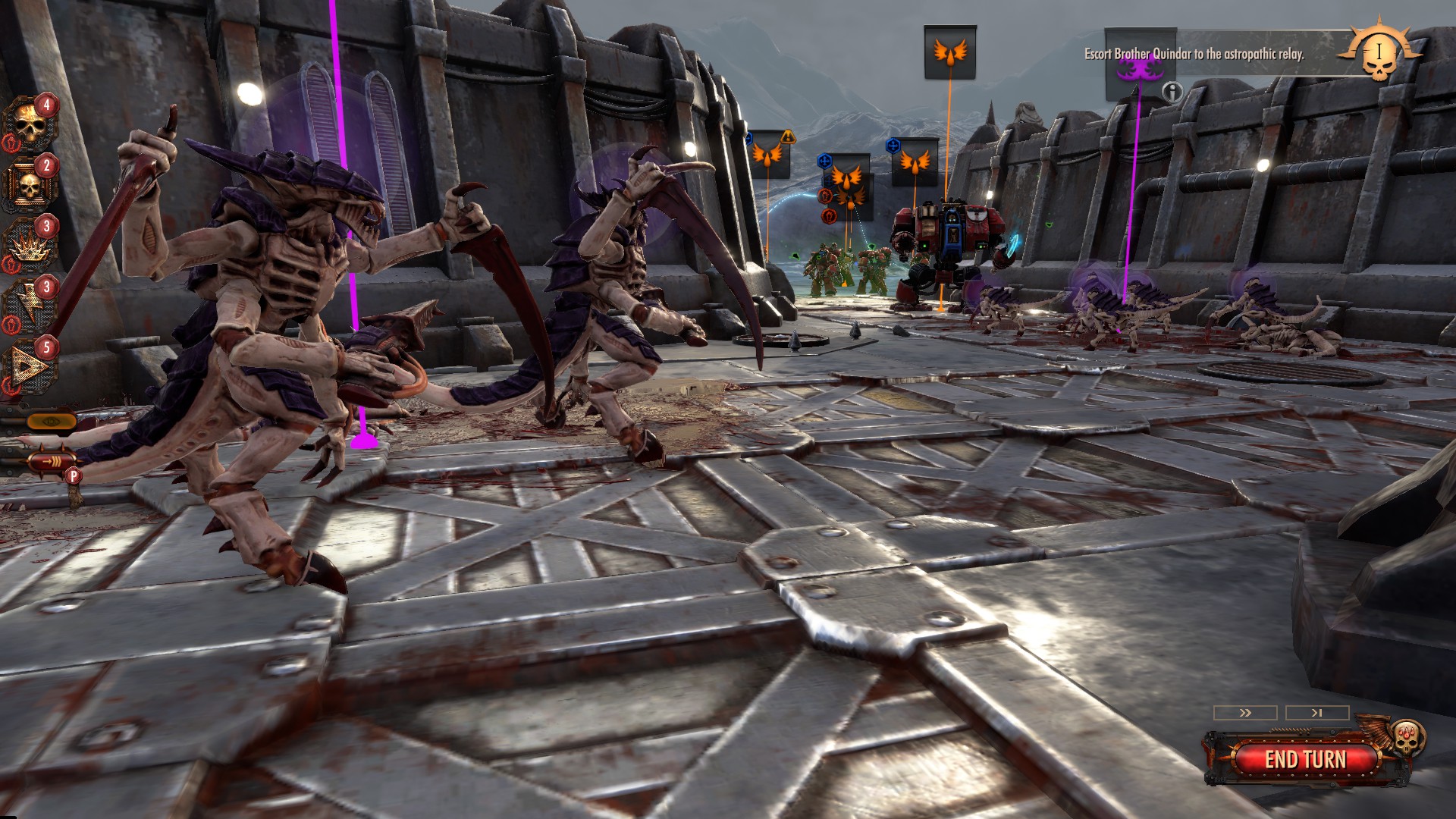
Presentation
Battlesector might not be an AAA game, but it still looks and sounds really good. This is the best looking game Slitherine has published to date, and while it might not be on par graphically with say the latest Total War titles it’s still one of the best looking strategy games on the market.
The highlight here are the way the different units look. They look true to their tabletop counterparts and are reasonably detailed. Zoom in too far and some textures might look a little bit blurry but as long as you’re not zooming in so far that a single model almost fills the screen they look good, and fans of the tabletop game will likely appreciate that pretty much every detail that’s on the physical models are represented here. Different weapons are also clearly visible, so if a unit swaps out its weapons that’s represented on the models.
Lighting effects are also good. Plasma bolts give off a cold blue light while bolter shots, which are small rocket propelled grenades, have a warm fiery glow. While coloured lighting effects like these have been a thing since the days of the Voodoo 1 graphics cards in the second half of the 90’s, they still look good when applied well, and they are applied well here.
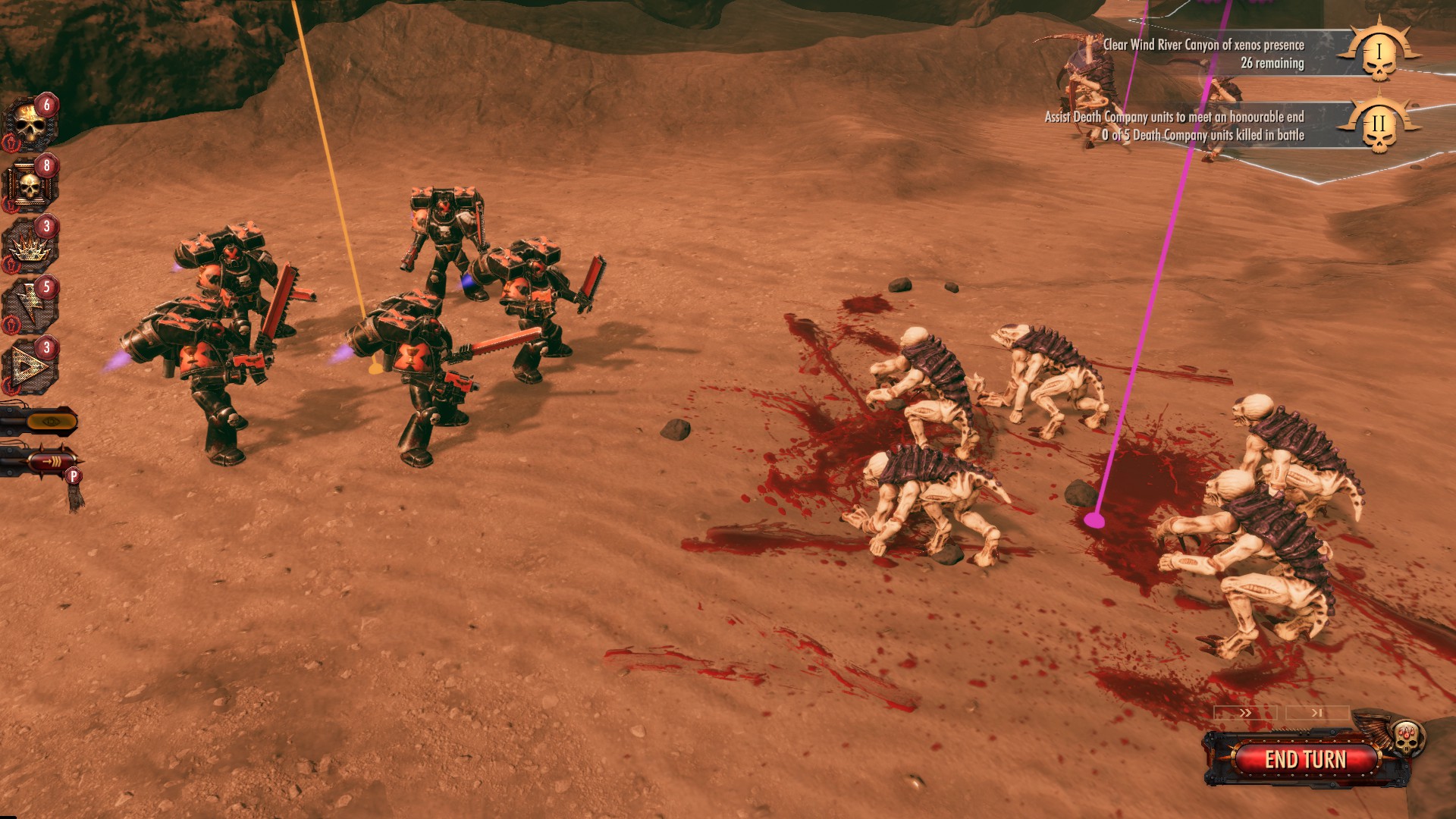
What does not look quite as good are the environments. The ground tends to look mostly flat and the textures are slightly blurry looking. The environments don’t look terrible, but it does stick out as noticeably worse looking than the character models. But once more you do get a lot of nice little touches here that long time fans of 40k might appreciate, like how certain clutter objects look almost exactly like terrain pieces that used to come with the 3rd edition Warhammer 40,000 starter set.
The sound design does not quite live up to the graphics, but it’s not too far from it. Most weapon fire sounds good, though a few guns could use a bit more base to really give them that “omph” that they should have, and it would have been nice if different materials had different sounds associated with them, after all a tank would not sound the same when driving on sand as when driving on steel. That’s nitpicking though, and the game overall does sound good. The soundtrack has a few nice tracks as well, but it mostly blends in with the background. This is no Chaos Gate (the old chaos gate from 1998, not the upcoming one) with its soundtrack, but it still does the job. What is impressive are the number of voice lines. Every unit has its own set of quips and barks for different situations, be it hearing enemies in the distance, shooting enemies or when you select them and it sounds like the voice actors were having a bit of fun with their roles, particularly the one who did the Death Company marines. This is not top tier Pixar-level voice acting, but it’s the kind of voice acting that fits a game like Battlesector. The voice actors also give some units a rather unexpected level of personality.
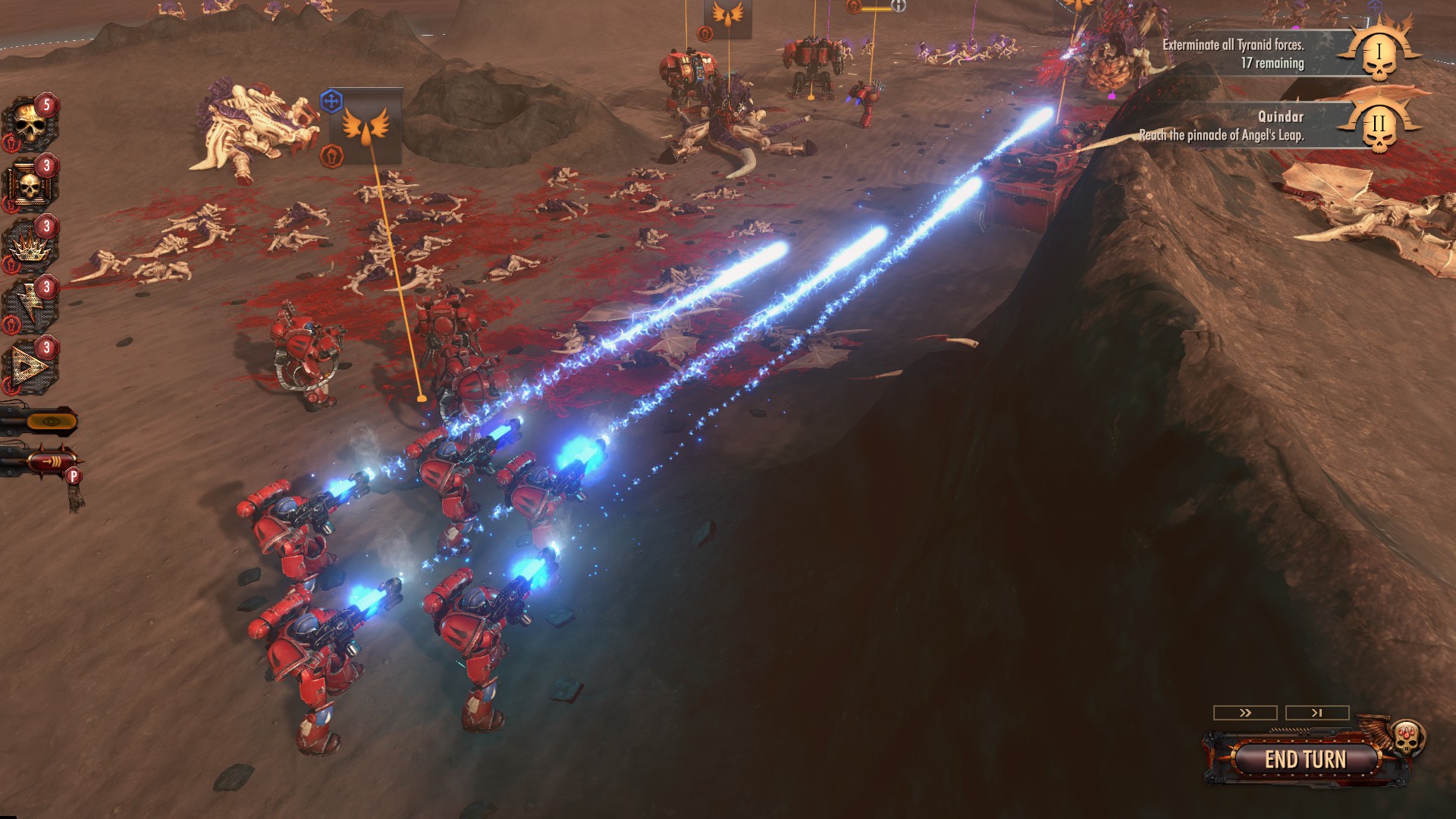
Gameplay
Battlesector is a turnbased tactics game where you move squads of soldiers around on a grid, If you’ve ever played Sanctus Reach then a lot of the basics will seem familiar, but Battlesector does have its own twists on the formula that makes it play differently.
Before any battle, be it campaign or skirmish, you get to design your own army with the troops you have available. In skirmish you have access to everything, but in the campaign you’ll get access to new units as the game progresses. Every unit has a “point cost” depending on how strong it is, a regular infantry squad for an example is relatively cheap while a big tank is far more expensive and you need to stay under the point limit. Heroic characters or vehicles are single-model units, while infantry comes in squads where the health of each squad member is tracked individually, and any lost squad members will lower the overall effectiveness of the squad.
Once the battle starts it’s time to start moving your troops around. Different troops have different movement values, with the nippy landspeeder being able to move quite far, while the lumbering aggressors are pretty slow. All units can move and shoot or attack in melee, though they can chose to forego their attack in order to move one extra square.
Attacking an enemy is as simple as clicking on it when you have a unit selected. Your unit will then fire their guns at the enemy, or strikes with their melee weapons. Not all guns are the same though, and a rapid fire assault cannon will shower the enemy with a hail of somewhat short range shots that individually deal little damage, but cuts through light infantry like butter, while a heavy plasma incinerator shoots a few high strength shots that are accurate at long range and cuts through armour like it was nothing there, but the low volume of fire means that they’re not as good at killing hordes. Cover also matters, and a unit that’s standing behind something solid, or even just another unit, is harder to hit. Even shooting through your own units lower your accuracy. The size if your units also matters here, a large Tyranid Exocrine (a kind of artillery monster) towers over the surrounding models and can’t really take cover behind smaller things.
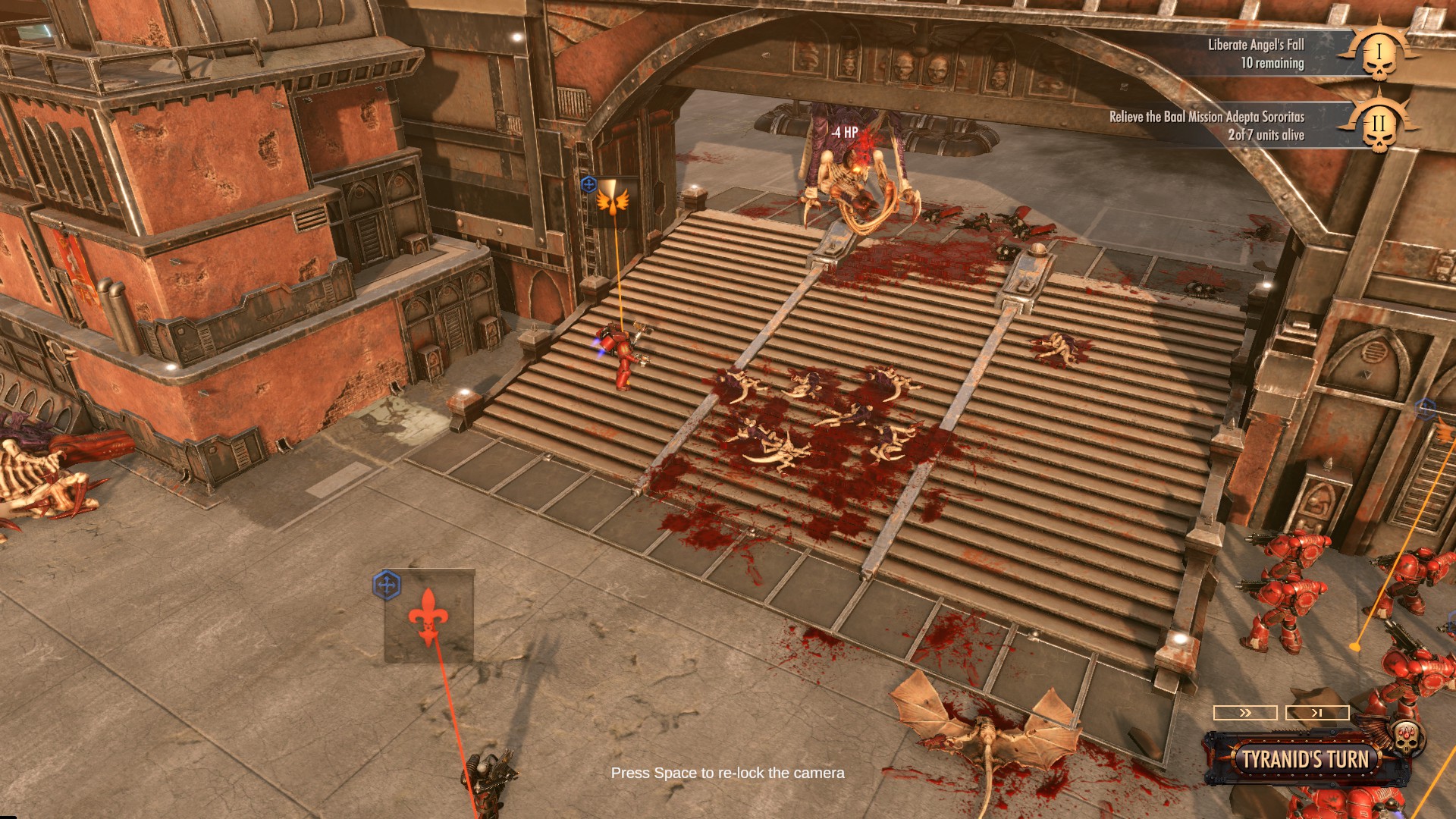
Most units have some kind of special abilities, usually with a cooldown. These tend to enhance what the unit already does, your basic infantry will be a bit more accurate with their shots, your melee infantry can get into close combat faster and so on. Heroes also have abilities that strengthen other nearby units, or heal them (of course depending on the hero), while also being powerful combatants in their own right.
Unit facing matters. Every unit is able to see what’s going on in their immediate surrounding and have a small “vision bubble”, but they also have a vision cone ahead of them that lets them see further than their limited vision bubble. A unit that did not use up its attack action during their turn can also shoot at the first enemy in a turn to enter their vision cone, and that are in range of their weapons. Some units, mainly the ones carrying melee weapons or pistols, also have a zone of control in front of them, which means that any time an enemy tries to move past them they’ll get a free melee swing.
Both the Blood Angels and the Tyranids have good mix of units, and while there are a lot of units that exists in the tabletop game that are not here, the ones that are here feel both varied and representative of what the two armies are meant to be like. The Blood Angels has an army of elite soldiers, few in numbers but skilled at what they do, wearing thick armour that small arms fire has a tough time penetrating. The Tyranids on the other hand has small, weak but plentiful infantry that individually don’t put up much of a fight, but come in such large numbers that they can tear down even the mightiest of foes, backed up by huge monsters that towers over the lesser creatures. Only the Blood Angels are available in the campaign, but in skirmish and multiplayer you can play as either side.
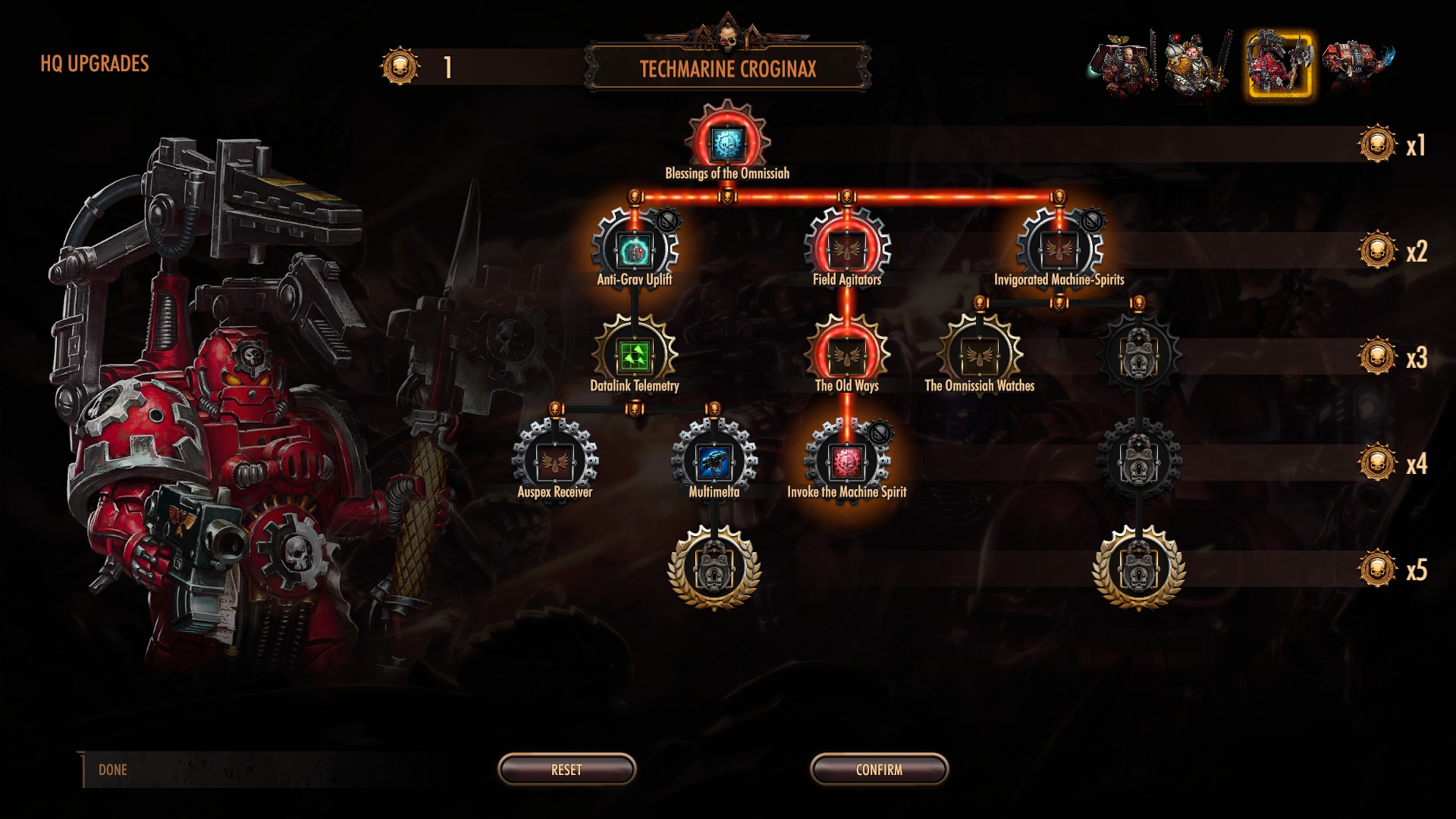
The campaign is linear. You’re going through a series of 20 missions following the attempts of the Blood Angels to exterminate the remaining Tyranids on the second moon of Baal. The game is well paced and things escalate pretty quickly, with both new units and new foes being introduced regularly. Early on you’re mostly going up against the small Tyranid creatures, like gaunts, but it won’t take long before larger creatures, several times the height of a human, start showing up.
Between missions you’ll get to upgrade your army. Beating a mission will give you points to spend in the games upgrade tree, and more upgrade trees will become available as the campaign progresses. These upgrades vary in terms of scope. Some will upgrade an individual hero, some will give passive boosts to all units of a certain type, or of certain types, some will unlock new weapons and a bunch will also unlock new abilities for your units. The significance of these upgrades varies considerably, the Hellblaster one which allows them to overcharge their plasma weapons, at the risk of taking damage, is really useful , while the interceptor’s ability to use a kind of charge move is not that great.
This might just be a bug in the pre-release version (it probably is), but most levels have secondary objectives that give you more points to spend in the upgrade tree, but the game does not tell you what the secondary objectives actually are. If this is still the case in the release version, then that’s a really strange design choice.
Taking losses in the campaign is not a big deal. Units are replaceable, and the only thing that you get from keeping a unit around for multiple levels are battle honours, which will be shown when you select your unit. These just tell you what levels you’ve used said unit in, but don’t seem to have any gameplay effect. All this really does is letting you know that you were indeed good at keeping your squad of virtual soldiers alive.
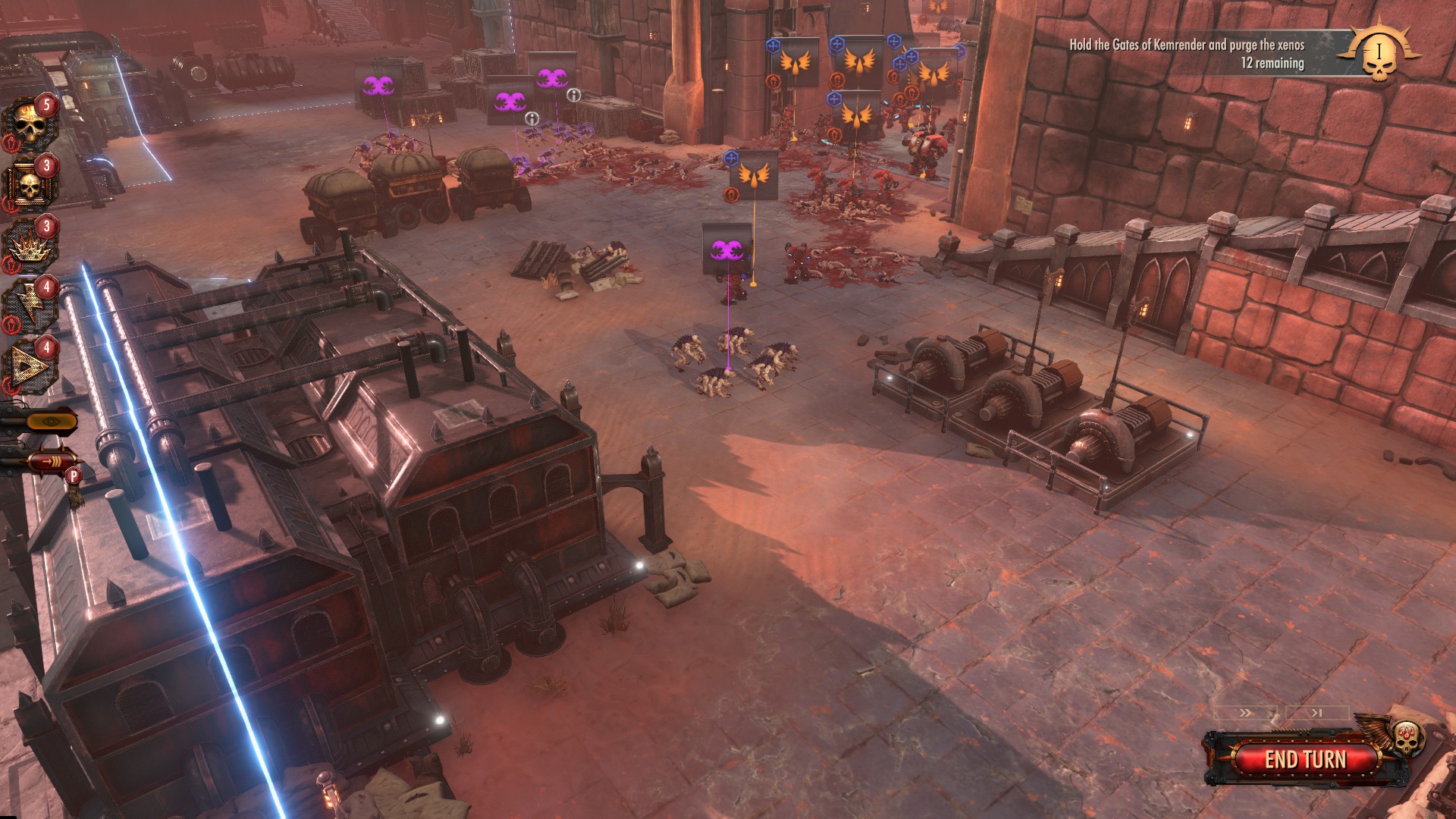
Closing Thoughts
There are a lot of really good turnbased tactics games out there, but Battlesector rises above the pack. It might not be the deepest turnbased tactics game on the market, but it’s one of the most fun, and it does a really good job at capturing the feel of the 40k setting, with better written dialogue than you would expect from a game like this. The story is a bit humdrum, but the game itself is a blast to play. Long time Warhammer 40,000 fans are in for a treat, and while the story might be somewhat confusing for those unfamiliar with the setting the gameplay is still so good that the game is worth playing.










